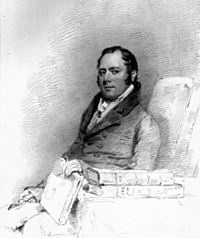George Ormerod facts for kids
Quick facts for kids
George Ormerod
|
|
|---|---|

George Ormerod
|
|
| Born | 20 October 1785 Manchester, Lancashire, England
|
| Died | 9 October 1873 (age 87) Sedbury, Gloucestershire, England
|
| Nationality | English |
| Education | King's School, Chester; Brasenose College, Oxford |
| Occupation | Historian |
| Spouse(s) | Sarah Latham |
| Children | William Piers Ormerod (anatomist); Eleanor Anne Ormerod (entomologist) |
George Ormerod (born October 20, 1785 – died October 9, 1873) was an English historian and a collector of old things, known as an antiquary. He is famous for writing a huge history book about the county of Cheshire in North West England. He was also a Justice of the Peace (a local judge), a Deputy lieutenant (a representative of the Crown), and a Fellow of the Royal Society (FRS), which means he was a respected scientist.
Contents
Who Was George Ormerod?
George Ormerod was born in Manchester, England. He received his early education at home and for a short time at the King's School in Chester. He then continued his studies privately.
Early Life and Education
In 1803, George went to Brasenose College, Oxford, a famous university. He earned his first degree in 1806 and an honorary master's degree in 1807. When he turned 21 in 1806, he inherited a lot of land in Tyldesley and other parts of Lancashire.
In 1808, he married Sarah Latham. Her father, John Latham (1761–1843), was a doctor. After they got married, George and Sarah lived in Rawtenstall for a short time before moving to Great Missenden. In 1810, he lived in a place called Damhouse in Astley.
Moving to Cheshire and Gloucestershire
George became very interested in researching the history of Cheshire. To make his research easier, he bought a house called Chorlton House and its estate, which was close to Chester. He lived there from 1811 to 1823 while working on his big history book.
After finishing his book, he moved to Gloucestershire. He bought an estate called Barnesville and renamed it Sedbury Park. He lived there from 1828 until he passed away. In Gloucestershire, he became a Justice of the Peace, helping with local law and order. He also served as a Deputy Lieutenant for the county in 1861. George Ormerod died at Sedbury Park and was buried nearby in Tidenham.
His Big Book: The History of Cheshire
George Ormerod's most important work was a detailed book called The History of the County Palatine and City of Chester.... It was a huge project that also included older historical writings about Cheshire.
He first printed a very rare version in two volumes. Then, he released the full work in ten parts, which eventually made up three large books, published between 1816 and 1819. He did much of his research by looking at old documents kept at Chester Castle. He also borrowed books and papers from important families in the county.
What Was in the Book?
George had assistants who helped him copy these old records. He also traveled all over Cheshire, visiting every town at least once to gather information.
Like other county history books from that time, his work mostly focused on:
- Family history: Tracing the stories of important families.
- Manorial history: The history of large estates and the people who owned them.
- Antiquarian topography: Descriptions of ancient places and their features.
He chose not to write much about businesses, factories, or growing cities. George wrote about a quarter to a third of the book himself. The rest was made up of copies of old documents and reprints of earlier works. A second, updated version of his book was published later, between 1875 and 1882.
In 1819, George Ormerod was chosen to be a Fellow of the Royal Society, which is a great honor for scientists and scholars.
Other Important Works
George Ormerod was involved in many historical and archaeological projects.
Restoring Ancient Crosses
In 1816, he helped organize the restoration of the old Saxon crosses in Sandbach. These are ancient stone crosses that are very important historical artifacts.
He also helped start several historical societies:
- The Historic Society of Lancashire and Cheshire in 1848.
- The Chester Archaeological Society in 1849.
- The Chetham Society in 1843, where he served on its council. For this society, he edited some books, including Lancashire Civil War Tracts in 1844.
Studying Roman History
After moving to Gloucestershire, George became very interested in the ancient objects and Roman history of that area. He published several books and papers about his findings. One of his notable works was Strigulensia (1861). This book was about the archaeology (the study of human history through digging up old things) of the area around Chepstow Castle. In the Middle Ages, this region was known as "Striguil".
George Ormerod's Family
George Ormerod and Sarah Latham married on August 2, 1808. They had a large family with seven sons and three daughters:
- Thomas Johnson Ormerod (1809–74), a religious minister.
- George Wareing Ormerod (1810–91), a lawyer and geologist.
- John Arderne Ormerod (1813–64), a religious minister.
- Susan Mary Ormerod (1814–96).
- Henry Mere Ormerod (1816–98), a lawyer.
- William Piers Ormerod (1818–60), an anatomist and surgeon.
- Edward Latham Ormerod (1819–73), a doctor.
- Arthur Stanley Ormerod (1821–84), a religious minister.
- Georgiana Elizabeth Ormerod (1822–96), who was a scientific illustrator.
- Eleanor Anne Ormerod (1828–1901), who became a famous entomologist (someone who studies insects).
See Also

